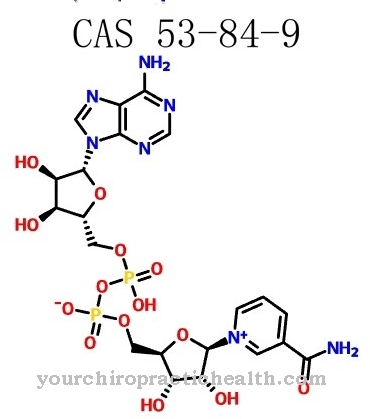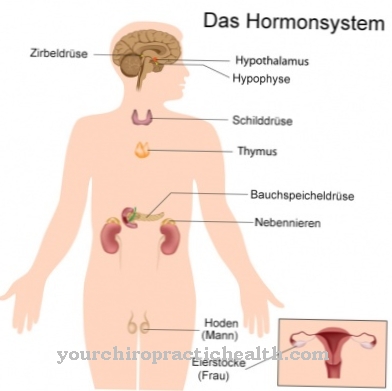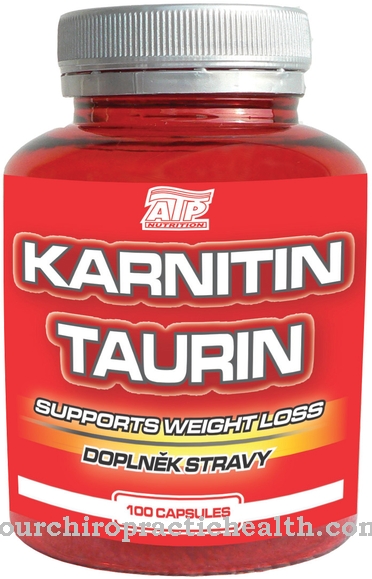Corticosterone is a steroid hormone that is produced in the adrenal cortex. Among other things, it serves the synthesis of aldosterone.
What is Corticosterone?
Just like cortisone, corticosterone is one of the steroid hormones. Steroid hormones are hormones that are built up from a basic steroid structure. This structure is derived from cholesterol. Cholesterol is an alcohol that belongs to the lipid group.
Steroid hormones such as corticosterone therefore also belong to the lipid hormones. Because they are lipophilic, they can easily penetrate the cell wall and can just as easily bind to their specific receptors inside the cell. Just like most other steroid hormones, corticosterol is also produced in the adrenal cortex. The lipophilic hormones are sparingly soluble in water, so they have to be bound to plasma proteins for transport in the blood.
Function, effect & tasks
Corticosterone is basically an intermediate that is used in the production of other steroid hormones. The hormone aldosterone is synthesized from corticosterone through several intermediate stages. Aldosterone is a so-called mineralocorticoid. It belongs to the group of corticosteroids and causes an increased recovery of water and sodium in the kidneys.
Another hormone made from corticosterone is pregnenolone. On the one hand, pregnenolone acts as a neurotransmitter and, on the other hand, it is the starting material for various steroid hormones. Current studies show that pregnenolone has a neuroprotective and neuroregenerative effect. So it not only protects the nerve sheaths, but also ensures the restoration of damaged nerve cells. In addition, pregnenolone has a positive effect on sleep behavior by activating GABA receptors in the brain.
Furthermore, the hormone seems to have an influence on the sexuality of women. Women with a low pregnenolone level are significantly more likely to suffer from libido disorders. The male sex hormone testosterone and the female sex hormone estradiol are also produced from pregnenolone via several intermediate routes.
In the human body, corticosterone also has a low glucocorticoid and a low mineralocorticoid effect. Glucocorticoids increase the blood sugar level by stimulating cellular glucose production, by stimulating glucagon secretion and by inhibiting insulin secretion. They also inhibit inflammatory reactions at various levels in the body. Mineralocorticoids, among other things, influence the electrolyte balance in the body.
Education, occurrence, properties & optimal values
The corticosterol is produced in the adrenal cortex. The starting product in production is cholesterol. This can come from the lipoproteins of the blood plasma, from the hydrolysis of cholesterol esters or from the de novo synthesis of activated acetic acid.
Progesterone is then produced from the cholesterol via a double hydroxylation. For this the 21-hydroxylase and the 11β-hydroxylase are required. Several intermediate steps then lead to the production of corticosterone. The normal range of corticosterone in the blood is between 0.1 and 2 micrograms per 100 milliliters. After the administration of ACTH, the value should be below 6.5 micrograms per 100 milliliters.
Diseases & Disorders
The production of corticosterone is stimulated by the release of ACTH. ACTH is a hormone made in the anterior lobe of the pituitary, the pituitary gland. In various diseases, the production and release of ACTH can be disrupted.
Elevated ACTH values can be seen, for example, in cold weather, stress, in adrenal insufficiency or in paraneoplastic syndrome. An increased ACTH release leads to an increased production of corticosterone and thus also to an increased formation of aldosterone. This condition is known as hyperaldosteronism. Hyperaldosteronism manifests itself in the form of a classic triad. On the one hand, the people affected suffer from high blood pressure.
Since too large a quantity of aldosterone is released and produced, the rate of reabsorption by the kidneys increases. Sodium and water are increasingly brought back into the body. This increases the blood volume and the pressure in the blood vessels increases. Hypokalaemia develops at the same time. When sodium ions are recovered in the tubular system of the kidneys, potassium ions are lost. In the course of the disease, metabolic alkalosis also develops. The blood pH rises above the normal value of 7.45 due to the loss of hydrogen ions.
Conversely, a reduced production of corticosterone can lead to hypoaldosteronism. As a result, patients excrete more water and sodium. Hyponatremia develops, which is accompanied by nausea, vomiting, and seizures. Changes in personality, lethargy and disorientation are also possible symptoms of a sodium deficiency. When more sodium is excreted, more potassium remains in the body. Hyperkalemia thus develops. Characteristic symptoms of such hyperkalemia are muscle weakness and paralysis. Cardiac complications can also arise. In the worst case, life-threatening ventricular fibrillation occurs.
With an increased production of corticosterone, the glucocorticoid effect can also be increased. An excess of glucocorticoids leads to Cushing's syndrome. Typical signs of Cushing's syndrome are obesity, tiredness, weakness, insomnia, high blood pressure and very thin skin (parchment skin). Due to the increased mobilization of glucose, secondary diabetes mellitus (diabetes) can develop. If the glucocorticoid effect is absent, those affected suffer from nausea, vomiting, weight loss and fatigue.
You feel weak and have trouble concentrating. If too little corticosterone and too few glucocorticoids are produced in the adrenal cortex, the pituitary gland releases more ACTH. This is usually accompanied by a release of melanin, so that there is an increase in pigment in the skin. The patients get brown skin as a result. In contrast to the holiday tan, the palms of the hands and the soles of the feet are also tanned with this tan.



.jpg)





.jpg)



.jpg)



.jpg)







.jpg)


